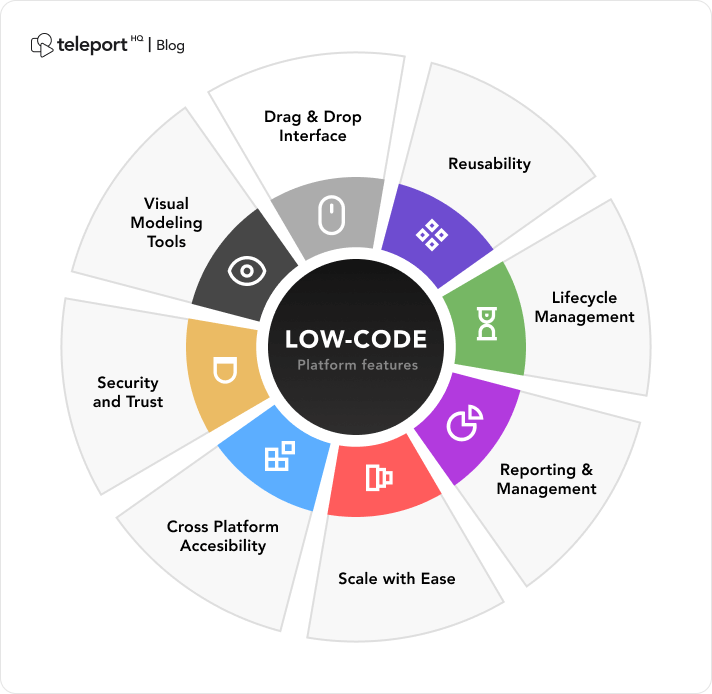Best Facts For Choosing Low-code platforms for application development
Best Facts For Choosing Low-code platforms for application development
Blog Article
The Advantages Of Low-Code Development For Application Development In Relation To Pertains To Integration Capabilities
Low-code application integration offers many advantages, including the capability to seamlessly integrate various systems and services. Here are a few of the main benefits: Prebuilt Connectors & APIs
Wide Range of Connectors Low-code platforms generally include a wide range of connectors that are pre-built for the most popular enterprise systems (e.g., CRM, ERP, databases, cloud services). It makes it easier to integrate these systems.
API Integration: A lot of Low-Code platforms include out-of box API integration features that let developers easily connect external services and data resources.
Simple to use:
Drag-and-Drop Integration integration tasks can usually be done using drag-and drop interfaces, making it possible to both developers and non-developers to design complicated integrations without writing a lot of code.
Visual Workflow Creators: These visually appealing tools used to create workflows and data flow make it easier for users to understand the process of integration.
Standardized Integration Methods:
SOAP and restful services: Supporting web-based services standard protocols like REST and SOAP makes integration simple with many different systems and applications.
OData Other Standards Support for standards such as OData allows transfer and manipulation of data across platforms and applications.
Real-Time Data Synchronization:
Low-code platforms allow for real-time integration between systems and applications. This allows information to be kept up-to-date and consistent across all departments of the business.
Event-Driven Architecture: A few platforms can support event-driven architectures. enabling applications to respond to events in real-time, which is crucial for interactive and dynamic apps.
Legacy System Integration:
Bridging old Systems and New Systems Low-code platforms often provide the tools needed to integrate with old systems. This allows organizations to upgrade their IT Infrastructure without re-designing their current systems.
Data Migration Tools - Built-in data-migration tools make it simple to move data from old systems to lower-code applications.
Integration of Third-Party Services:
Cloud Services Integration: The seamless integration of cloud services like AWS Azure, Google Cloud makes it easy to deploy and scaling-up of applications.
Business Applications Low-code platforms can be used to be integrated with different business applications like Salesforce, SAP or Microsoft Dynamics. They allow the creation of a seamless workflow for all business processes.
Simplified Data Processing:
Unified Data Models: Some low-code platforms provide unified data models that makes data integration and management across various platforms.
Data Connectors are pre-configured data connectors which provide rapid access to data sources and allow manipulation.
Security and Compliance
Secure Integrations Low-Code platforms are designed to make sure that integrations adhere to security protocols and standards. This ensures the security of the data in transit as well as when it is stored.
Compliance Features - These platforms have features to make sure that the integrations are in compliance to regulatory requirements.
Extensibility:
Low-code platforms enable the creation of custom scripts and programs to satisfy more complicated integration needs. The flexibility available without compromising the ease of use.
Plug-in Ecosystems: A plugin ecosystem can be used to expand the integration capabilities and allows users to expand the functionality as needed.
Overall, the capabilities for integration of low-code applications development platforms make them an effective instrument for developing interconnected, efficient and scalable applications. They are able to streamline the process for connecting disparate systems, and increase the flow of information. Companies can benefit from existing technologies and adopt new ones, while ensuring a seamless IT environment. Have a look at the top Low-code Platform for application development for blog advice including app development platform, developing mobile apps, multiplatform mobile app development, app development platform, software for app development, app dev platform, azure sql databases, app modernization, build a docker container, cross platform mobile dev and more.
Low-Code Development's Cost-Effectiveness Is One Of The Main Advantages.
Low-code development offers many advantages in terms of cost effectiveness. This makes it an ideal choice for companies looking to optimize their development budgets while still delivering high quality applications. Here are the top benefits: Reduced development costs:
A lower code platform makes it less necessary to write extensive manual coding. This means less time and effort on the part of developers when developing their applications. This leads to lower costs of labor.
We require less developers: Development that is low-code requires shorter time, and it is simpler. This means that there are fewer developers needed. It could reduce hiring and staffing costs.
Speedier time to market
Accelerated Development Cycle Visual development tools and pre-built parts offered by low-code platforms allow for rapid application development, which allows companies to get their products on market faster. This could lead to faster revenue growth and improve your position in the marketplace.
Rapid prototyping: By constructing rapid prototypes and testing them quickly companies can cut down on the amount of time they invest in the development stage and also allow for faster iterations based on user feedback.
Low Maintenance Costs
Due to their modularity and standard components, apps built on low-code platforms are easier to maintain. This reduces the cost of maintenance and support.
Automated Updates. Many low-code platform handle patches and updates automatically. Applications are secure and safe without the need for extensive manual input.
Efficient Resource Utilization:
Low-code platform contributions allow both business users and others who are not developers to take part in the creation process. This democratization enables companies to benefit from the skillsets of a wide range of employees.
Improved utilization of IT resources IT departments will be able concentrate on strategic initiatives, rather than being buried in mundane development tasks. This will improve overall productivity and efficiency.
Scalable Pricing Models
Subscription-Based Price: Many low code platforms offer flexible subscription-based pricing that scales with usage. This lets businesses make sure that their budget is in line with their real needs and growth.
Pay-as-you-go options - Some platforms allow businesses to pay only for what they use. This is especially beneficial for startups or small businesses with a limited budget.
Reduce the cost of Third-Party software:
Built-in Functionalities : Low-code software often comes with built-in functionality and integrations, which eliminates the requirement for additional third-party tools, software and licenses.
Pre-Built Integrations with popular services and systems it can save you time and money by avoiding the requirement to create custom integrations.
Better ROI:
Faster Return on Investment: Rapid development, lower cost, and quicker time to market, means that businesses can achieve a faster return on investment (ROI) on their apps.
Enhanced Ability. Companies will be able to adapt quickly to the ever-changing market conditions and customer demands. This will allow them to remain relevant, and they will be able to profit from any new opportunities.
The cost of training is less:
Low-Code Platforms have User-Friendly Interfaces. The user-friendly and intuitive interfaces cut down on the learning curve for new users. This minimizes the need for intensive training programs.
Accessible Resources: Many low-code platforms offer complete training materials and tutorials along with community assistance. These resources reduce the requirement for formal instruction and its associated cost.
Collaboration can be streamlined.
Improved Collaboration Tools: Built-in collaboration tools help improve communication and coordination among team members, leading to improved development efficiency and reduced project overhead.
Unified Development Environment (UDE): A single, unifying development environment streamlines workflows, reducing cost and complexity that comes with managing multiple platforms and tools.
In the end, the value of low-code application development stems from its ability to cut the cost of development and maintenance and speed up the time to market, improve resource utilization, and provide flexibility in pricing. These elements provide huge economic benefits to companies. Low-code is a fantastic option for companies that wish to make the most of their budgets, but also create robust, scalable and high-quality software. Follow the top sources tell me about Legacy application modernization with Low-code for more tips including cross platform mobile dev, cross platform mobile dev, application development platforms, no code platforms, developing mobile apps, mobile app development platforms, rapid app development, push notifications, jdbc server, rad application development and more.
Benefits Of Low-Code Application Development In Terms Of Community Support And Vendor Support
Low-code development platforms for applications have significant advantages in terms of the support provided by vendors and communities. These is essential to ensure an effective implementation, ongoing maintenance, and continuous enhancement of applications. Here are some of the main benefits.
Comprehensive Technical Support:
Support Teams Dedicated to You A lot of low-code platforms have dedicated support teams who can help with technical issues, problem-solving and advice. This will ensure that any issues are swiftly solved.
24/7 Support Availability: Some vendors offer around-the-clock support that is especially beneficial for businesses that operate globally and in different time zones.
Training and Onboarding:
Structured training programs: Vendors offer structured training courses, such as webinars or courses for certification. This allows users to quickly grasp the platform.
Personalized Onboarding Many vendors provide personalized services to help their new customers get onboard effectively and customize it to their needs.
Regular Updates and enhancements:
Continuous Improvement : Low-code platforms vendors often release regular upgrades that include new functionality as well as performance improvements and security patches. These updates make sure that their platform is current and secure.
Feedback Integration: Vendors include user feedback in their development cycles to ensure that the platform is constantly evolving to meet the evolving needs of its users.
Comprehensive Documentation:
Detailed Documentation: Extensive and well-organized documents are usually available for download, covering everything from basic usage to advanced customization. This helps users to find solutions on their own.
API References: API documentation is detailed and aids developers in integrating APIs with other platforms, and to further adapt their apps.
Consultancy and Professional Services
Expert Consulting: Most companies offer consulting services for architectural planning, strategic planning and complicated implementations. This helps users maximize their platform's potential.
Custom Development: Certain companies offer services that permit them to create specific features, or incorporate integrations, which aren't available out of the box.
Community Support for the Community
Active User Community:
Discussion and Forums: A lot of Low-code platforms offer lively online communities where users are able to ask questions, debate solutions, and collaborate with one another on the best methods.
Local and virtual User Groups and Meetups, provide opportunities for users to share their experiences, share their knowledge with other users, and connect with.
Collaboration and knowledge sharing:
Community-Contributed Resources: Users often share templates, modules, and extensions that they have developed, which can be reused or adapted by others, accelerating development and innovation.
Crowdsourced Solutions: The collective knowledge, experience and expertise of a community may be a valuable tool for problem-solving and finding innovative solutions.
Learning and Development
Community-Led Learning: Several communities host workshops, training sessions, and webinars, which are usually directed by experts who can provide insights and advanced techniques.
Online Tutorials and Courses Community members make and provide tutorials, online classes and guides on how to use. This enhances the learning resources that are accessible to all users.
Feedback and Influence
Product Feedback: Several community forums have channels for giving feedback to vendors. This can influence new features and improvements.
Beta Testing Programs Participants in the Community who are active could have the opportunity of participating in beta programs. This allows them to get an early view on the latest features, as well as the chance to influence the platform’s evolution.
Recognition and Support
Community Recognition Programs: Several vendors have recognition programs to honor the efforts of active community members like MVP (Most Valuable Professional) programs.
Peer Support. Community members provide assistance to each other. They share their knowledge with less experienced users and provide guidance. This creates an environment that is supportive and collaborative.
Overall, the combination of robust support from the vendor and an active and engaged community creates a comprehensive support ecosystem for the development of low-code applications. Users will be able to gain access to the experts, resources and collaboration opportunities that they need in order to successfully build and deploy, manage and further enhance their apps.